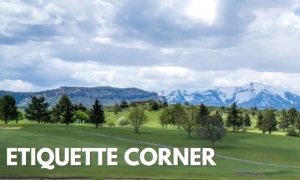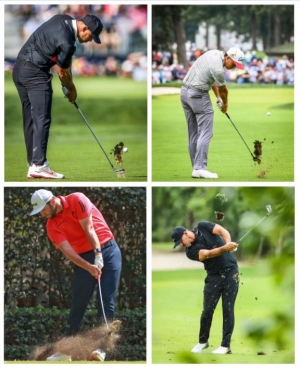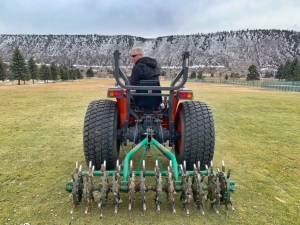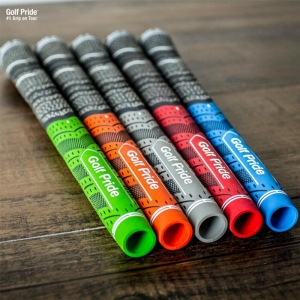Etiquette Corner - Pace of Play, Golf Cart Use, Music, and More!
Greetings and welcome to the first edition of the Hillcrest Etiquette Corner, where we will periodically discuss the general etiquette and rules that are expected when participating in the game of golf.
Over the past two years, we have introduced so many new golfers to the game. Men, women, families, and juniors, golfers young and old who have no experience at all or who have returned to golf after years away. It’s quite amazing to see the excitement level for the sport, and we hope that enthusiasm carries on for years to come! New and changed perceptions of a sport once thought of as “old-time” or “boring” have helped new golfers overcome the “stuffy” cogitations of the past. It’s undoubtedly the perception change our sport needed to survive the future.
As we introduce new golfers to the sport, it’s important that we all know what is expected of us while inside the clubhouse, on the golf course, or casually hitting a bucket of range balls. These etiquette tips will provide both our new and seasoned golfers a chance to reflect on the question, “Am I meeting expectations?”
Please take the time to read through these simple but important etiquette tips. If you have any suggestions for future etiquette and rules questions, please email us at This email address is being protected from spambots. You need JavaScript enabled to view it..
Pace of Play Tips
Don't be the slowest player in your group

A casual round of golf at Hillcrest should not exceed 2 hours and 5 minutes for 9 holes, or 4 hours and 15 minutes for 18 holes. Often times, when groups are aware of pace, you'll find it easy to finish under these expected timeframes. It’s important to evaluate your pace of play honestly and often. If you’re consistently the slowest one in your group, you’re a slow player, period. Encourage everyone to move quickly enough so you find yourself right behind the group in front several times, both early and late in the round.
Play ready golf
Ready golf means if you're ready to hit your next shot, GO FOR IT! — regardless if someone else is “out” or further away. Unless you’re playing a high-stakes match play style of competition, there’s no need to wait for others to hit their golf ball if you're ready to sink a 20-footer or to hit a “bomb,” as Phil Mickelson would say.
Read your putt while others are putting
We see a lot of golfers wait to line up their putt until the previous player has already marked their ball. Instead, be proactive: Line up your putt as others are putting. Just be sure you are sufficiently far enough away to not be diverting, and once their ball is rolling, place your ball down and begin your putting routine. If your ball isn’t in the way, you can put it down and pick up your spot before it’s your turn to hit.
Use of Golf Carts
Make your golf cart "invisible"
Carts are very much a part of the modern game. Your goal when driving a cart should be to leave no trace that you were there. Because we tend to look where we’re going and not where we’ve been, it’s easy to damage the turf without realizing it. Avoid wet areas and spots that are getting beaten up from traffic.
Many golfers tend to play “follow the leader” and drive in single file out to the fairway before branching off. It’s usually better to scatter—where everyone takes a different route—so cart traffic is spread out.
Where can we drive carts?
It's always acceptable to drive golf carts on cart paths. Rough surrounds and fairways are usually fair game unless they’re marked with signs like “keep carts on path,” arrows indicating that carts should move towards the cart path, or “ground under repair."
Golf carts are NEVER permitted to be driven on tee boxes, green surfaces, green surrounds (fringe or collar), or close to any water hazards. Bottom line: Please respect the golf course when driving a cart! Your maintenance team works tirelessly to provide golfers an exceptional playing product. Please also respect the golf cart unit itself, too. It’s not a bumper car or off-road vehicle; it’s simply a vehicle to get you safely from golf shot to golf shot.
Hitting Into the Group in Front of You
If there is one universal, unbreakable etiquette rule, it's this:
If there is ANY chance that your shot could hit the player(s) in front of you, do not hit your ball. Do not hit your ball into the group in front of you. Instead, wait.
You should never, ever, ever hit into other people if there is even the remotest possibility that your shot could reach them. No matter how long you’ve been waiting to hit that shot. No matter how angry you are. No matter how poorly you’ve been hitting the ball that day. No matter if you “usually don’t hit the ball that far.” You simply do not do it.
It’s incredibly selfish, undeniably dumb, and unbelievably dangerous.
Music on the Golf Course
Music on the golf course has become more common in the last 5 to 10 years as the sport transitions into a more welcoming environment for all participants. There are certainly golf traditionalists that will never engage with the idea of music on the golf course, which is totally an acceptable viewpoint. There is a time and place for music on the golf course. A casual round of golf with the friends or a fun scramble event, absolutely. A Club Championship or the Navajo Trail Open, definitely not.
Here are some rules for music on the course. Follow these and you will stay out of the “Public Comments” section of the next Board Meeting.

Training Tips - The Moment of Truth: Impact
One of the most important aspects of golf is impact. Striking the ball and controlling the clubface through impact affects everything from ball flight to distance and direction.
This is something the pros understand very well. If you take a look at these four photos, you'll notice several similarities. Starting with the top of the body down, the first conversation is always about the eyes. It's not just about keeping your head down but keeping your eyes focused on the ball without blinking. Notice how each pro's eyes are down, watching the ball compress off the face, and they remain down well after the golfer has swung through the ball.
Proper Form is Key
To do this, your body has to rotate completely around the eyes. Moving your body in this way creates the proper the path for the arms to find the ball. In these photos, you'll notice how consistently the right hand is square at impact to the target. If you can allow the right hand to stay quiet—not turned over and not twisted—it facilitates the face of the club to also remain square to the target at impact.
Moving down to the core, all four photos show the same positioning. Each player's belly (not his hips) are facing the target. This can't be done without core rotation, but you don't need to lift your head to do it. Through impact, the eyes remain focused downward as the core rotates around the eyes.
Finally, look at the feet. The right heel is flat through impact to anchor the rotation. It only starts to come up after the core has fully rotated, twisting the body to create a follow through that drives the ball to the target.
So how do you get there? It starts with knowing how to do it, but it comes with practice. Start by working on impact without the velocity of the tour pro. Where do you want to be at the moment of truth? With focused eyes, quiet right hand, core rotation, and anchored feet. Once you become mechanically sound, you can begin to amp up the speed
A Day in the Life of Ken Kirby & The Hillcrest Maintenance Team
Greetings Hillcrest golfing community! I’m Bill Gwinn, a newly elected Hillcrest board member and the chair of the grounds committee. I’m an avid golfer and a big fan of our golf course. What’s not to love about Hillcrest? The views here are incredible, and the course itself is pristine. As part of the grounds committee, I’ve had the opportunity to spend behind-the-scenes time with our maintenance team, and I’ve learned so much about the role they play in maintaining our fantastic golf course. I wanted to share that exclusive look by painting a picture of the day in the life of Hillcrest’s Superintendent, Ken Kirby, and the Hillcrest maintenance team.
Ken started at Hillcrest in April of 1985. He was on the Fort Lewis golf team, getting a double major in economics and business (and maybe drinking a few Coors along the way). He needed a summer job, and Rick Kern, Hillcrest’s former superintendent, took Ken under his wing and started teaching him the tricks of the trade. In 1987 Ken became the assistant superintendent and he took over as superintendent in 2008.
Ken never talks in terms of "I" or "me." He talks about his crew, assistant superintendent Will Herz (who has been at Hillcrest for 25 years), and second assistant Eric Dunn. The team does it all together, and they complement each other to create an incredible team.
As I drive up to the maintenance shop, it’s not unusual to see Ken mowing the lawn around the building. This is often done after an early start and long morning taking care of the golf course! Ken and his team take great pride in the overall appearance of the property, and they service both the golf course and the areas surrounding the course. Have you noticed all the gorgeous flowerpots and gardens around the clubhouse this year? Those are thanks to our incredible maintenance staff!

The day starts out at 5am when Ken and Will take the initial look at the course. They are looking for anything out of the ordinary, checking the greens, fairways, and bunkers while also paying attention to factors like tree limb height and any potential irrigation leaks. They finish at the clubhouse, where they water the flowers and prepare the clubhouse area for early morning golfers. When they head back to the maintenance shop, they’ll meet with the rest of the crew around 5:45am. It’s an early morning push for the whole team! Jobs are divided out and the crew gets to work. The crew needs at least 90 minutes to get the course ready for the first tee time, and Ken and Will have each task scheduled down to the minute.
The greens—the “crown jewels” of the course—must be mowed every day, rolled five times per week, and top dressed once per week to keep them playing smooth and fast. Every other week, the greens are also verticut
(a de-thatching process that keeps the greens healthy). Fairways are only cut three times a week, but the rough is mowed every day. It takes two crew members two full days to cut all of the rough at Hillcrest! The crew also needs to rake and edge the bunkers before play, limb up any errant tree limbs, check irrigation pumps, mow and prepare the practice greens and tees, and cut cups on the greens to keep play interesting for golfers. Let’s not forget about trash and bathrooms that are cleaned daily. It’s a busy morning, to say the least.
There is so much more to the work they do, but I don’t want to write a novel. Just think what it takes to maintain your lawn and garden, multiply that by at least 100, and try to cram it into 90 minutes (all while having golf balls whizzing by your head). Both Ken and Will said, “There is always something to do,” many times in our conversation. Of course, there’s always a problem to solve, too. If a mower breaks down, there’s an irrigation break, or a greens mower breaks a hydraulic line, Ken and Will turn to mechanic mode and have to fix the problem fast so the Hillcrest golfing community can get out there and have a fantastic time golfing.

I was always under the impression that winter was a golf crew’s time to relax and enjoy some time with their families. I was told that is not the case. Winter is a very busy time for the grounds crew. Starting the day after the course closes for the winter, the crew starts sharpening blades on the mowing equipment. Hillcrest has 11 riding mowers and many more hand mowers and string trimmers, all of which need sharpening and general maintenance so they’re ready to go when the snow melts. There is also the ski track on a good snow year. After we get enough snow to groom the course, the grounds crew gets up as soon as there is light and starts to rough in the ski track. This usually takes an entire day if it all goes perfectly, although it often takes two days. After the ski track is roughed in, then begins daily grooming to keep the track in great condition. There is also snow removal and if ice is forming on the greens, and this past spring the team had to remove the snow from the greens with a snow blower.
I knew how much work they did, but after talking to them to write this article, I’m even more impressed with the job our grounds crew does at Hillcrest. When I asked Ken if there is anything he wants our members to know, he said that the grounds crew alters their schedule as much as possible to keep play consistent for the golfers. For example, they change the day they top dress or edge the traps so anyone who plays on a specific day of the week isn’t always golfing under these conditions. They try to perform aerification and other necessary (but play-hindering) tasks during times that won’t impact a tournament or peak play. In the end, they believe that the grounds crew’s goal is to prepare the best golf course possible with consistent play for all handicaps and all abilities, every day.
Our golf course is very busy in the morning—you know that if you’ve ever tried to get an early tee time! But the busiest time for golfers is also the busiest time for our grounds crew. As a golfer, I don’t always think about all of the work that goes into preparing and maintaining a golf course. I’m thinking about my round and trying to break that dreaded 90. So, the next time I see a grounds crew member working while I play, I’ll try not to be annoyed at him for running a loud string trimmer or mowing close to my ball that I can barely see in the rough. Instead, I’ll give him a nod and thank him for all the work he has done—including all that work that I never even see!
From the Golf Shop - Grips & Club Repair
If you've ever had a club repaired or re-gripped at Hillcrest, you've probably met Bud Andersen. Hillcrest is one of the few places in Durango that offers full club repair, and Bud has been fixing clubs for 31 years. Break your shaft? Bud can fix it. Need to tune your club's loft and lie? No problem. Clubs too long or short? We'll cut them down or add extensions.
Grips are the most common club repair done at Hillcrest. Many prefer regripping in the spring so the clubs don't sit on new grips all winter long. That said, end-of-season grips are common for anyone looking to use their golf shop credits.
As a general rule of thumb, you'll want to regrip your clubs once a year. Golfers who play less than once a week can probably get away with regripping every couple years. You'll know it's time to re-grip your clubs when they start to crack. If your grips feel slicker than they used to, that's also a good indicator. You can regrip your clubs for years—Bud often sees clubs that are 15 to 20 years old. That said, at a certain point, you may want to upgrade technology with a new set of clubs.
The best type of grip for you has a lot to do with personal preference. Each grip has a different level of padding, as some golfers prefer firm and others play better with soft grips. Oversized grips are ideal for anyone with large hands, but they may also be a good fit for people with arthritis or hand pain as they're easier to hold. Grip textures also vary from smooth to textured, and some are better suited for use in different weather conditions. You'll also want to consider if your hands sweat while golfing or you don't use a glove. A quick conversation with our Golf Shop employees might be enough to identify your best grip, but we can also do club fitting to help you find a good fit.
Club repair prices and timelines really depend on the type of repair. Grips are $3 per club, plus the cost of the grip. We carry juniors, ladies, men's standard, midsize, and oversize grips. If we don't have the grip you like in stock, we can order it for you. If we have everything in stock, a regrip can take as little as one day. Other repairs may take two to three days, depending on the repair.
The very best way to figure out if your clubs need repair, and what choice to make when repairing them, is to check in with the experts. So don’t be afraid to ask the next time you’re at the counter!






